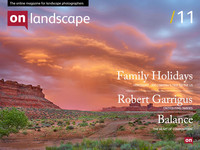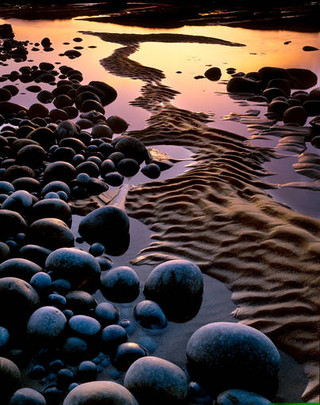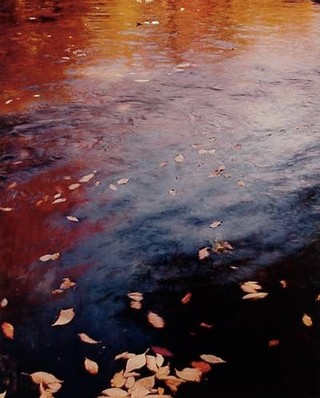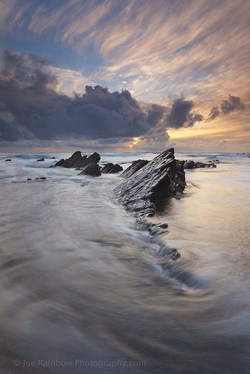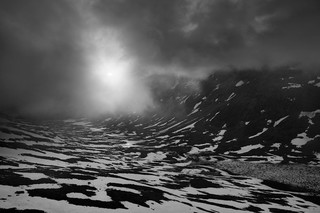Tim Parkin's thoughts on why we take photographs

Tim Parkin
Amateur Photographer who plays with big cameras and film when in between digital photographs.
I've just read an article in a popular outdoor photography magazine that was written in defense of shooting sunsets that I can't help but write a reaction to.
He does say in the article that he knows many photographers who think that "capturing a sunset as a creative end in itself is a waste of time". Well I think I probably fit into that category so I figure I'd best explain why.
But first of all I'll start by stating that taking photographs of anything for any reason is perfectly valid and I wouldn't deny anyone the right to take photographs of whatever the hell they want to take pictures of. Part of the problem in reacting for or against an article like this is in approaching the question of "why do we take photographs in the first place". There are hundreds of answers to this I can imagine, from "because I like playing with cameras" to "I'm trying to communicate the meaning of my life" via "I like calling myself a photographer" and "I'm obsessed with coloured/black and white stuff" but I'll try to cover a few that I think may make sense to readers of this website.
Am I taking pictures for myself or for others?
If you are taking photographs just for yourself then there is nothing that is bad or good. The only person who matters is yourself and so the only arbiter of quality or subject is yourself. The only reason that other people may matter is if you have a self imposed peer group that you challenge yourself with. For example Vivian Meier was a street photogapher from Chicago who never showed her pictures to anybody but who obviously had a sense of 'art' and had various street photographers as an influence. In this case, I believe that although she never showed her art to someone else, she was definitely creating her art for herself but also for an imaginary audience of some sort
If you are taking pictures with an audience in mind (imaginary or otherwise) then the audience can be anything from a general general public who are totally unfamiliar with landscape photography (beyond the type of art that they absorb through a cultural osmosis) through various levels of art aware individuals and also to other photographers.
So is your desired audience artistically aware? Do they like the visual equivalent of pop music or jazz?
For me, and quite a few of the photographers I talk to, their primary goal through photography is to express themselves in an original and creative way and to share that with a group of artistically minded peers. There are also photographers that work primarily because it’s something they enjoy and they like a challenge to see if they can create the best photograph they can.
The two goals I’ve listed above seem quite complementary but there is a fundamental flaw in the second in that the ‘best photograph’ is a subjective thing and the audience that ends up being defaulted to is ‘other photographers’, either on photo sharing websites or camera clubs, etc. The worst thing isn’t the fact that it’s other photographers, it’s the fact that the feedback from these other photographers is given as judged in a tiny amount of time and by a small picture and, online at least, the final result is a statistical anomaly judged by how much you comment on other pictures, write about your own pictures, how often you post, etc, etc.
Now I’m not suggesting that there is anything inherently wrong with playing the camera club/photo sharing website game. The main thing to be sure of is that you are driving things, not letting it drive you. You can choose which feedback to react to and which to ignore and in the end you can gain from using these resources.
What has all this got to do with sunsets though? Well, it’s to do with being in control of why you take photographs and having a plan of how to progress your craft.
In any craft/art, you learn the most when you are challenged the most. If as painists we stayed with 4/4 tempo in C major with octaves and fifths on the left hand then although a non-pianist may be impressed by what we can do, we will be limited in our potential for creativity. Introducing minor keys and sevenths increases the potential for musicial texture dramatically. I see sunset/sunrise pictures as the equivalent to C major (with coastal sunsets as C major 7ths to push an anology) and although they may have a place, we should be looking at balance. We should challenge ourselves to take photographs in cloudy weather or at midday, in the rain or fog. By challenging ourselves, we bring our problem solving head into action and by doing so we stand more chance of finding solutions that are unique to ourselves.
Using my musical analogy, it would be foolish to dismiss sunsets as irrelevant. Just as major chords are a significant part of much music, using the warm light of a sunset or sunrise can be a significant part of a photographers pallette. But I would say that to make something creative and original out of a sunset or sunset light you need to have a ‘plan’ - an approach that can shape the work you do rather than just reacting to the environment. Even with single pictures, if you use the the light or sunset itself as just an ingredient in a wholesome meal.
I’ve included some sunset/sunrise pictures from various artists here with a short commentary against each. All of these photographers have taken a sunrise and used it's light in a way that creates something original and beautiful.
In Joe's case, he has chosen to use a the glow of the sunrise as a reflection in the pools of tidal water, creating almost modernist shapes from the pebbles and shapes. Eliot Porter has done the same thing but gone even further to use the second hand light from the banks of the river and mixed it with the inky blacks of the water. The texture of the water's flow and the scattered leaves add detail to what if one of my favourite of Eliot's pictures. Joe Rainbow has captured an outcrop of stone that acts as a wonderful foil to the energetic water flows and dynamic skies, using the light of sunset to illuminate a magic moment. Magnus Lindbom, a photographer I found out about when he was recommending Lapland locations has captured a the raw luminosity of the sun as it breaks through the clouds above a zebra striped raw landscape.

